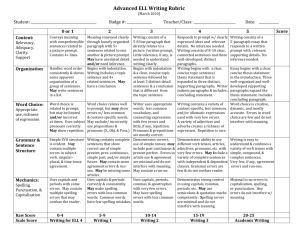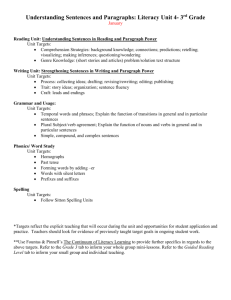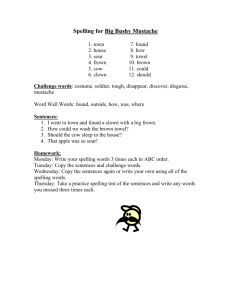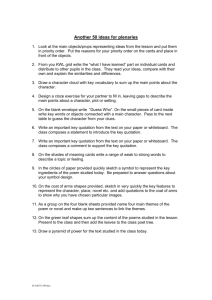Skills to Emphasize in Writing for ELL 4, Writing 1, and Writing 2
advertisement
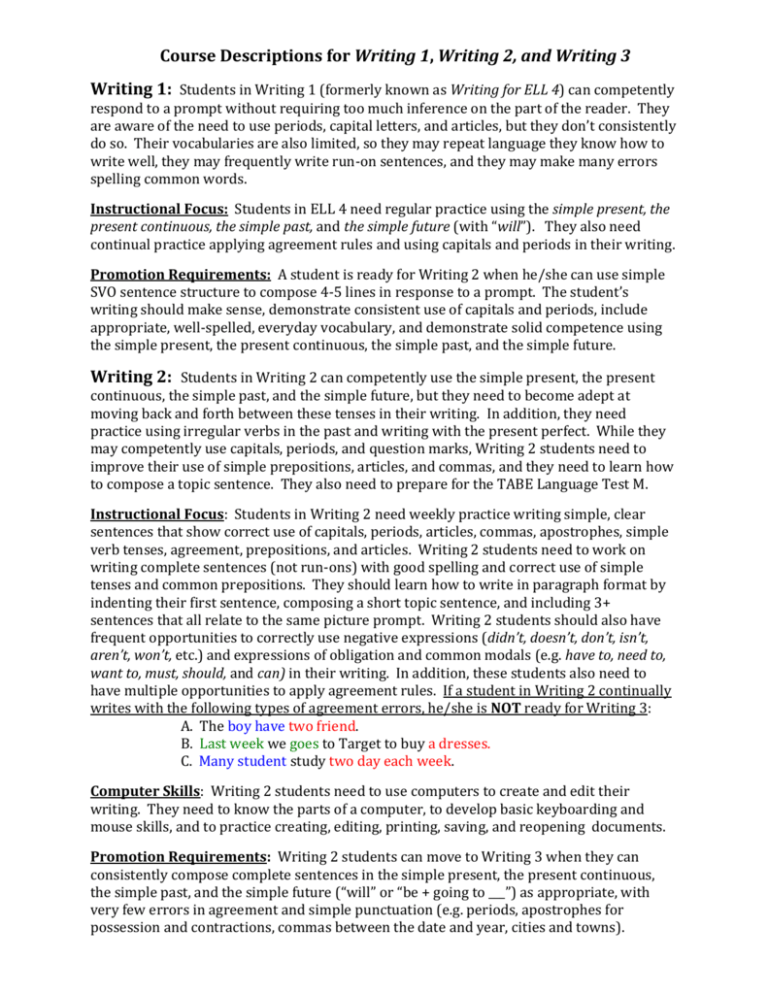
Course Descriptions for Writing 1, Writing 2, and Writing 3 Writing 1: Students in Writing 1 (formerly known as Writing for ELL 4) can competently respond to a prompt without requiring too much inference on the part of the reader. They are aware of the need to use periods, capital letters, and articles, but they don’t consistently do so. Their vocabularies are also limited, so they may repeat language they know how to write well, they may frequently write run-on sentences, and they may make many errors spelling common words. Instructional Focus: Students in ELL 4 need regular practice using the simple present, the present continuous, the simple past, and the simple future (with “will”). They also need continual practice applying agreement rules and using capitals and periods in their writing. Promotion Requirements: A student is ready for Writing 2 when he/she can use simple SVO sentence structure to compose 4-5 lines in response to a prompt. The student’s writing should make sense, demonstrate consistent use of capitals and periods, include appropriate, well-spelled, everyday vocabulary, and demonstrate solid competence using the simple present, the present continuous, the simple past, and the simple future. Writing 2: Students in Writing 2 can competently use the simple present, the present continuous, the simple past, and the simple future, but they need to become adept at moving back and forth between these tenses in their writing. In addition, they need practice using irregular verbs in the past and writing with the present perfect. While they may competently use capitals, periods, and question marks, Writing 2 students need to improve their use of simple prepositions, articles, and commas, and they need to learn how to compose a topic sentence. They also need to prepare for the TABE Language Test M. Instructional Focus: Students in Writing 2 need weekly practice writing simple, clear sentences that show correct use of capitals, periods, articles, commas, apostrophes, simple verb tenses, agreement, prepositions, and articles. Writing 2 students need to work on writing complete sentences (not run-ons) with good spelling and correct use of simple tenses and common prepositions. They should learn how to write in paragraph format by indenting their first sentence, composing a short topic sentence, and including 3+ sentences that all relate to the same picture prompt. Writing 2 students should also have frequent opportunities to correctly use negative expressions (didn’t, doesn’t, don’t, isn’t, aren’t, won’t, etc.) and expressions of obligation and common modals (e.g. have to, need to, want to, must, should, and can) in their writing. In addition, these students also need to have multiple opportunities to apply agreement rules. If a student in Writing 2 continually writes with the following types of agreement errors, he/she is NOT ready for Writing 3: A. The boy have two friend. B. Last week we goes to Target to buy a dresses. C. Many student study two day each week. Computer Skills: Writing 2 students need to use computers to create and edit their writing. They need to know the parts of a computer, to develop basic keyboarding and mouse skills, and to practice creating, editing, printing, saving, and reopening documents. Promotion Requirements: Writing 2 students can move to Writing 3 when they can consistently compose complete sentences in the simple present, the present continuous, the simple past, and the simple future (“will” or “be + going to ___”) as appropriate, with very few errors in agreement and simple punctuation (e.g. periods, apostrophes for possession and contractions, commas between the date and year, cities and towns). Writing 3 Writing 3 students should already know what a topic sentence is, but they need continual practice outlining and writing a 5-8 sentence paragraph that includes a topic sentence, at least 3 related, supporting sentences, and a concluding statement. Instructional Focus: While in Writing 3, students should continue to practice using the simple past, simple present and simple future appropriately in their writing, and they should develop proficiency in using the past continuous and the present perfect. Although Writing 3 students have seen definite and indefinite articles before, they need frequent practice in knowing when to use a, an, the, (or nothing) with count and non-count nouns (e.g. I’d like to buy a book; I’d like to buy the red book on that shelf; I buy books very often; Books are interesting). Students in Writing 3 also need to practice making their writing more interesting by using a variety of language such as synonyms, connecting words & expressions, adjectives, adverbs, adverbial clauses, compound & complex sentences, etc. Finally, Writing 3 students need regular practice completing exercises that will prepare them to take the TABE Language Test M. Computer Skills: Writing 3 students will continue to improve their computer skills. They will use Microsoft Word to create and edit documents. In addition, they will learn to copy, cut and paste, to change fonts and font sizes, to use tool bar icons, to adjust line spacing, and to use the dictionary, spelling, and thesaurus tools. It would be beneficial if they also learned to use Google Docs to save their work. Promotion Requirements: In order to be promoted to Writing 4, students in Writing 3 must be able to independently compose (in 30 minutes) a simple paragraph in response to a picture or written prompt with very few errors in verb tense use, articles, punctuation, spelling, and agreement. The sentences they produce must relate well to the prompt and to one another, they must be easy to understand, and the writing must flow in a logical order with no run-ons.

